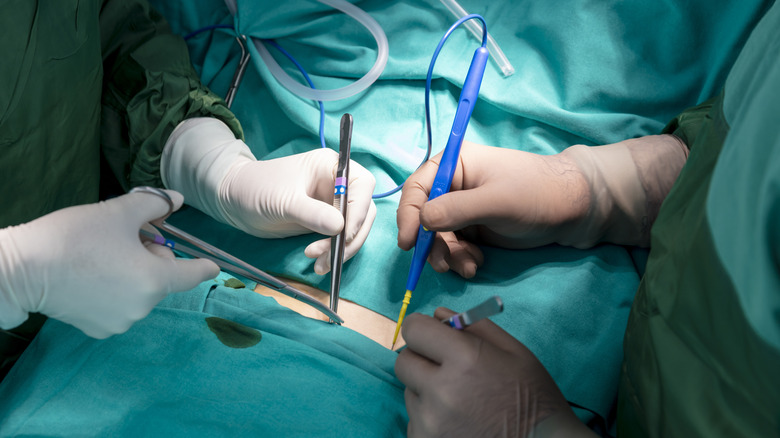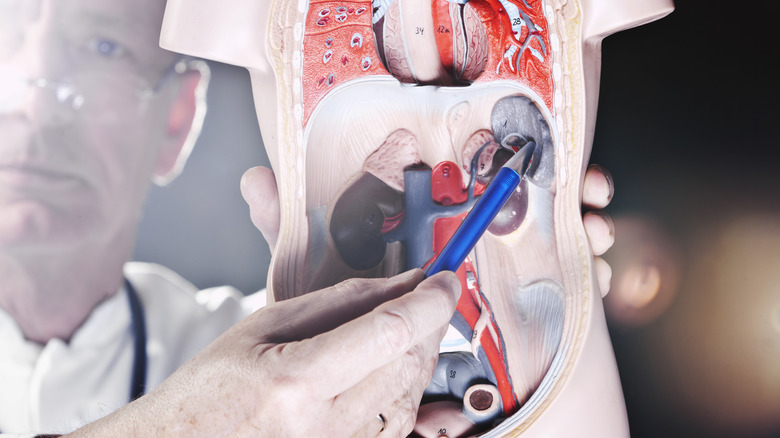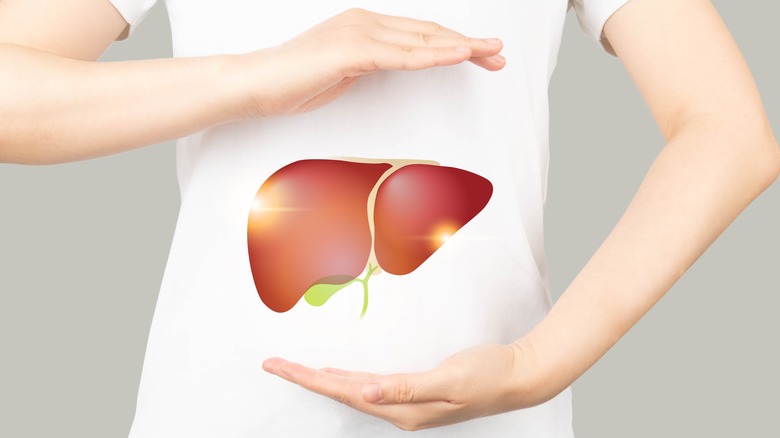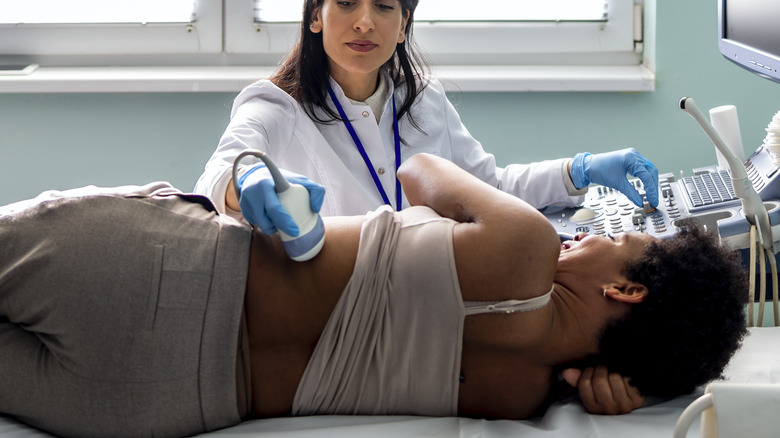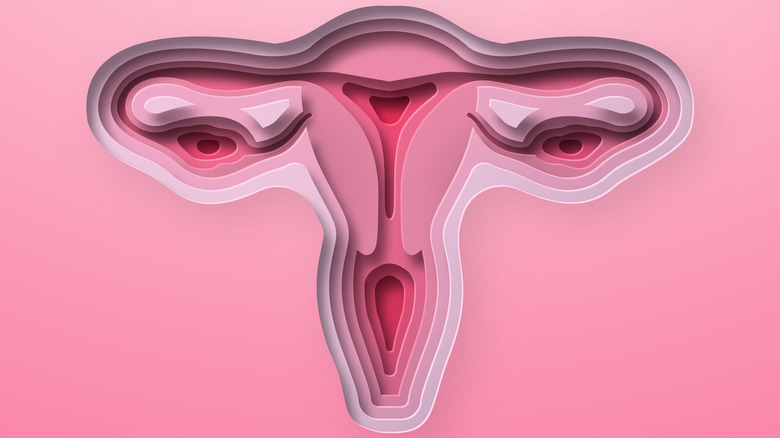You Won't Die If You Have These 12 Organs Removed
We often take our organs for granted. In most cases, they work behind the scenes, doing what they need to do to keep us alive without any help from us. Sometimes, they encounter a problem, and we need to intervene. Medications or other treatments may heal them or at least keep them going. But what happens when treatments won't help? We can't just remove organs, right?
Actually, you can. In fact, humans can live without a surprising number of organs. Now, there are certain organs you can't live without — the heart, brain, and skin, for example. But a handful of others are, in a way, "optional." For example, the appendix doesn't really do anything in the body of modern humans. And you can live without one lung because the other can shoulder the burden in its absence.
Read on to find out more about which organs you can let go of (if medically necessary, of course), and how the body functions in their absence.
Spleen
The spleen, tucked away beneath the ribcage on the left side, is one of those organs you might not think about often. Yet, it plays several essential roles in your body's day-to-day functions. It's involved in filtering out damaged or old red blood cells, fighting infections by producing white blood cells, and storing platelets and other essential immune cells (via StatPearls).
While the spleen is undoubtedly valuable, it's possible to live without it. Some people are even born without a spleen, and sometimes the spleen is removed due to trauma or specific medical conditions like spleen enlargement or a ruptured spleen. In this case, other organs step up to fill the gap.
The liver, for example, takes on the job of filtering damaged blood cells (via Merck Manual). At the same time, the bone marrow ramps up its production of the necessary immune cells (via a study in Cancer). Over time, these adaptations make up for the absence of the spleen, ensuring that the body's defenses and blood-filtering processes continue to operate. However, it's important to note that without the spleen, the body may be more susceptible to certain bacterial infections. Hence, doctors might recommend specific vaccines and sometimes antibiotics for those living without a spleen to counteract this vulnerability.
Appendix
A small, tube-like structure located at the top of the large intestine, or colon, the appendix was thought to be a vestigial organ, meaning it was a leftover evolutionary remnant with no particular function in modern humans (via West Texas A&M University). This comes from the fact that people can live without an appendix without any notable long-term health consequences.
However, research has uncovered some potential roles the appendix might play. Some scientists believe the appendix may serve as a "safe house" for beneficial gut bacteria. Certain diseases can affect the bacteria in the intestines, and the appendix might repopulate the gut with healthy bacteria, aiding recovery. Another hypothesis is that the appendix plays a role in the immune system, particularly during the early years of life, by exposing the body to various antigens and aiding in the maturation of immune cells (via a review in Clinical & Experimental Immunology).
While these functions might make the appendix seem important, the human body can adapt well without it. This is evident in the number of people who have appendectomies: 300,000 each year in the U.S. (via the Cleveland Clinic). The procedure is commonly done when there is inflammation of the appendix, called appendicitis. If untreated, appendicitis can lead to the appendix bursting and result in serious complications.
In the absence of the appendix, the body continues its digestive and immune functions unimpeded. Other parts of the immune system compensate for the loss, and the beneficial bacteria in the gut find ways to thrive and repopulate when needed.
Tonsils
Tonsils, often visible as two fleshy mounds at the back of the throat, play an active role in the body's immune system. Part of the lymphatic system, tonsils work at the forefront of the body's defense system against bacteria and viruses that enter through the mouth or nose (via MedlinePlus). Acting as gatekeepers, they're tasked with trapping these unwanted invaders and helping to make antibodies to help combat these pathogens (via UVMHealth).
However, tonsils are not without their complications. Sometimes, they can become a site for infection themselves, leading to conditions like tonsillitis, which manifests as swollen, painful tonsils, often accompanied by fever. If tonsillitis becomes chronic or if the tonsils get overly enlarged to the point of causing breathing or swallowing difficulties, a tonsillectomy (surgical removal of the tonsils) might be recommended. This procedure, particularly common in children, leads many to question the true necessity of tonsils.
While tonsils do have a function, humans can live without them. Once they're removed, the body doesn't just become defenseless against infections. Instead, other components of the immune system adapt and compensate for the absence of the tonsils. It's unclear whether or not they compensate enough. Some research shows that removing the tonsils does impair the immune system (via the University of Melbourne). However, frequent infections can reduce quality of life, and as yet, there is no agreed-upon alternative to a tonsillectomy.
Adenoids
Adenoids are a small pair of soft tissue masses located in the back of the nasal passage, right behind the nose and the roof of the mouth. As a part of the lymphatic system, they're cousins to the tonsils and function as a line of defense in the immune system. Adenoids are more prominent in children and tend to shrink with age (via Nemours Kids Health).
The adenoids work as filters, trapping pathogens in inhaled air and preventing them from going further into the body. They also produce antibodies, which aid in fighting off potential invaders. Given their frontline position in the nasal passage, they're often one of the first parts of the body to detect and combat airborne pathogens.
But just like tonsils, adenoids can become problematic. They can become enlarged, causing breathing difficulties, snoring, or recurrent ear infections. Enlarged adenoids might obstruct breathing, forcing children to breathe through their mouths. This obstruction can lead to disturbed sleep and sleep apnea. If these problems persist, a procedure called an adenoidectomy, which is the surgical removal of the adenoids, may be recommended.
Post-adenoidectomy, many worry about increased vulnerability to infections. However, as is the case after the removal of tonsils, the body can adapt (via a study in Medicine). When adenoids are removed, other parts of the immune system step up to take over their protective function. Other tissues and organs in the immune system, such as the spleen, lymph nodes, and tonsils (if still present), compensate for the absence of adenoids.
One lung
The lungs are an essential part of our respiratory system, responsible for the vital task of bringing in oxygen and expelling carbon dioxide. These spongy organs, located within the chest and protected by the ribcage, work tirelessly throughout our lives. With each breath, air travels through the trachea and into the bronchial tubes. Small sacs called alveoli fill with air, allowing oxygen to enter the bloodstream and carbon dioxide to be expelled (via the National Heart, Lung, and Blood Institute).
As crucial as the lungs are, it is possible to live with just one functioning lung. The reasons for removal, known medically as a pneumonectomy, can range from cancer to severe infections or traumatic injuries. When one lung is removed, the remaining lung expands to occupy the space and, over time, can increase its capacity to compensate for its missing partner (via Johns Hopkins Medicine).
While people can function with a single lung, they may face limitations. The total lung capacity is reduced, which can lead to decreased endurance during physical activities. People might find themselves becoming breathless more quickly or needing more time to recover after exertion (via WebMD). High-altitude places where oxygen is scarcer might also pose a challenge.
That said, many individuals with one lung lead full, active lives. With appropriate medical care, physical therapy, and gradual conditioning, many regain a significant portion of their previous physical capabilities. It's essential for someone with one lung to remain under the care of a pulmonologist and avoid habits harmful to the lungs, like smoking.
Gallbladder
A small, pear-shaped organ located beneath the liver, the gallbladder's primary function is to store bile, a digestive fluid produced by the liver that aids in breaking down fats during digestion. After a meal, the gallbladder releases bile into the small intestine to aid in the digestion of fatty foods (via the Cleveland Clinic). While the gallbladder plays a supportive role in digestion, it's not absolutely essential to the body's overall digestive process.
Some people develop gallstones, hard particles that can block the normal flow of bile and cause pain, inflammation, and infection. In some cases, a doctor may recommend removing the gallbladder through a procedure called cholecystectomy. Once the gallbladder is removed, the liver takes on the role of releasing bile directly into the small intestine. However, instead of releasing bile in larger quantities after meals, the liver continuously secretes a smaller amount of bile directly into the digestive system. While the process of fat digestion can still occur, it does become less efficient, especially with larger, fattier meals. As a result, people without a gallbladder may need to change their diet, consuming smaller, more frequent meals and reducing their intake of high-fat foods.
With these adjustments, many people live without their gallbladder without significant disruption to their daily lives. Digestion continues, and with mindful eating habits, most people can avoid digestive discomfort.
One kidney
Most people are born with two kidneys, fist-sized organs located on either side of the spine. Their primary role is to filter and remove waste products and excess fluids, including electrolytes, from the blood to form urine. They also regulate some important bodily functions, such as controlling blood pressure, producing red blood cells, and balancing minerals in the body (the Better Health Channel).
However, if one kidney is lost or donated, the remaining kidney can take over these functions. It does so by increasing in size and enlarging its filtration capacity, a process known as compensatory hypertrophy. This means the solitary kidney enlarges and works at a greater capacity to handle the work previously managed by two kidneys (via a study in Nature Communications).
In instances of living kidney donation, where someone donates one of their kidneys to a person with kidney failure, both the donor and the recipient can lead healthy lives post-transplant. The donor's body quickly adjusts to function optimally with the single kidney, while the recipient's body begins to benefit from the transplanted, functioning kidney.
While it's certainly possible to live a healthy life with only one kidney, some lifestyle changes are necessary. Regular medical check-ups are crucial to monitor kidney function. Adopting a balanced diet, maintaining a healthy weight, controlling alcohol and salt intake, staying hydrated, and being careful with over-the-counter pain medications are some measures that help ensure the health and longevity of the remaining kidney (via Healthline).
Uterus
The uterus, or womb, is where a baby grows and develops during pregnancy. During childbirth, its muscular walls contract, helping to push the baby out. It also plays a key role in the menstrual cycle, as its lining thickens in preparation for a potential pregnancy and sheds during menstruation if pregnancy doesn't occur.
Despite its crucial role in reproduction and menstruation, it is possible for a woman to live without her uterus. Full or partial surgical removal of the uterus, called hysterectomy, is a common procedure; in fact, it's the second most common surgery for women, with around 300,000 performed each year in the U.S. (via WebMD). Women have hysterectomies for various reasons, including uterine fibroids, endometriosis, cancer, chronic pain, or heavy bleeding.
If the ovaries are removed during hysterectomy, women will enter menopause due to the reduction in hormone production. If the ovaries remain intact, they will continue to produce hormones. While a woman won't have menstrual periods, she won't enter menopause. However, she may enter menopause earlier in life than she normally would have.
Women who undergo this procedure can no longer have children, but their life expectancy and overall health are not negatively affected. Complications are rare, and in many cases, a hysterectomy improves the quality of life for women suffering from debilitating conditions. Without the uterus, they often find relief from chronic pain or excessive bleeding, allowing them to lead more active, fulfilling lives.
Some lymph nodes
Lymph nodes are small, bean-shaped structures that play a crucial role in the body's defense against infections and diseases. They act as filters, trapping viruses, bacteria, and other foreign substances, which are then destroyed by white blood cells known as lymphocytes (via the Cleveland Clinic). Distributed throughout the body, they are primarily located in the neck, under the arms, in the chest, abdomen, and groin.
Lymph nodes are a part of the lymphatic system, which is responsible for maintaining fluid balance in the body, filtering harmful substances from the lymphatic fluid, and supporting the immune system. The lymphatic fluid, known as lymph, carries waste products away from the tissues and back into the bloodstream.
Lymph nodes are important for a healthy immune response, but it's possible to live without some of them. People frequently have lymph nodes removed during surgeries, especially in cases of cancer where they might be examined to check for the spread of the disease or removed to reduce the risk of further spread (via the Cleveland Clinic). Removal can lead to a condition called lymphedema. Because the flow of lymph has to be redirected, it can lead to fluid buildup and swelling in the arms, head, neck, genitals, or legs. Although there is no way to prevent lymphedema, staying active after treatment can help reduce the risk (via Johns Hopkins Medicine).
Prostate
The prostate is a small gland located in between the bladder and the penis, right in front of the rectum. It's an essential part of the male reproductive system, responsible for producing a fluid that forms a part of semen. As men age, some may encounter medical conditions related to the prostate, including benign prostatic hyperplasia (BPH), prostatitis, or prostate cancer. In particular situations, especially when prostate cancer is diagnosed, the surgical removal of the prostate gland might be advised (via Johns Hopkins Medicine).
Living without a prostate is not a problem, but the procedure can have side effects. The primary concerns after surgery are urinary incontinence and erectile dysfunction. Many men eventually regain full bladder control, but others might face ongoing issues. Regarding erectile function, recovery varies and depends on factors like overall health and the type of surgery performed. According to City of Hope, most men will experience some kind of sexual dysfunction. However, there are steps they can take to regain healthy sexual function, including medication, counseling, pelvic floor, exercises, and surgical implants. Losing weight, eating a healthy diet, and quitting smoking can also help.
Testes
The testes, or testicles, are two oval-shaped organs that sit inside the scrotum, the skin pouch below the penis. They are important components of the male reproductive system and play two primary roles: producing sperm and synthesizing the male hormone testosterone. This hormone is responsible for the development of male reproductive tissues, promoting male sexual characteristics like facial hair and a deeper voice, and sexual function.
In certain situations, a man might lose one or both testes. This could be due to conditions like testicular cancer, trauma, or transgender transition. The absence of one testicle generally doesn't affect a man's ability to produce sperm or testosterone, as the remaining testicle compensates for the loss. However, if both testes are removed, a man will no longer produce sperm and will become infertile. Additionally, levels of testosterone may fall, which can cause symptoms like fatigue, loss of muscle mass, reduced libido, depression, erectile dysfunction, and osteoporosis (via the Cleveland Clinic).
Testosterone replacement therapy (TRT) can help counteract these effects. Additionally, men who hope to have children can bank sperm prior to the procedure (via Cancer Research UK). Psychological and emotional support post-procedure are crucial for helping men adapt to the challenges presented by the loss of one or both testes.
Ovaries
The ovaries, two almond-shaped organs on either side of a woman's uterus, are essential parts of the female reproductive system with two main roles: producing eggs and releasing hormones, namely estrogen and progesterone (via the Cleveland Clinic). These hormones regulate menstrual cycles, influence fertility, and play a role in physical features specific to women. Before menopause, ovaries release mature eggs for potential fertilization. If an egg isn't fertilized, menstruation occurs. Additionally, the hormones produced by the ovaries support pregnancy and affect bone health, among other things.
One or both ovaries might need to be removed for various reasons, including ovarian cancer, cysts, or as a preventive measure for those with a high risk of breast or ovarian cancer due to genetic factors (via the Mayo Clinic). Living without ovaries does bring about changes. Without them, the body can't produce the same levels of estrogen and progesterone. This can lead to early menopause, which comes with symptoms like hot flashes, mood changes, night sweats, and vaginal dryness. There's also an increased risk of osteoporosis, a condition where bones become weak and brittle. A woman may also become infertile; however, there are methods that can potentially prevent this, depending on the situation.
Women can live a healthy life without ovaries. Hormone replacement therapy (HRT) can help women manage the symptoms of menopause and the risks associated with reduced estrogen. It involves taking synthetic hormones to replace those the body no longer produces.
